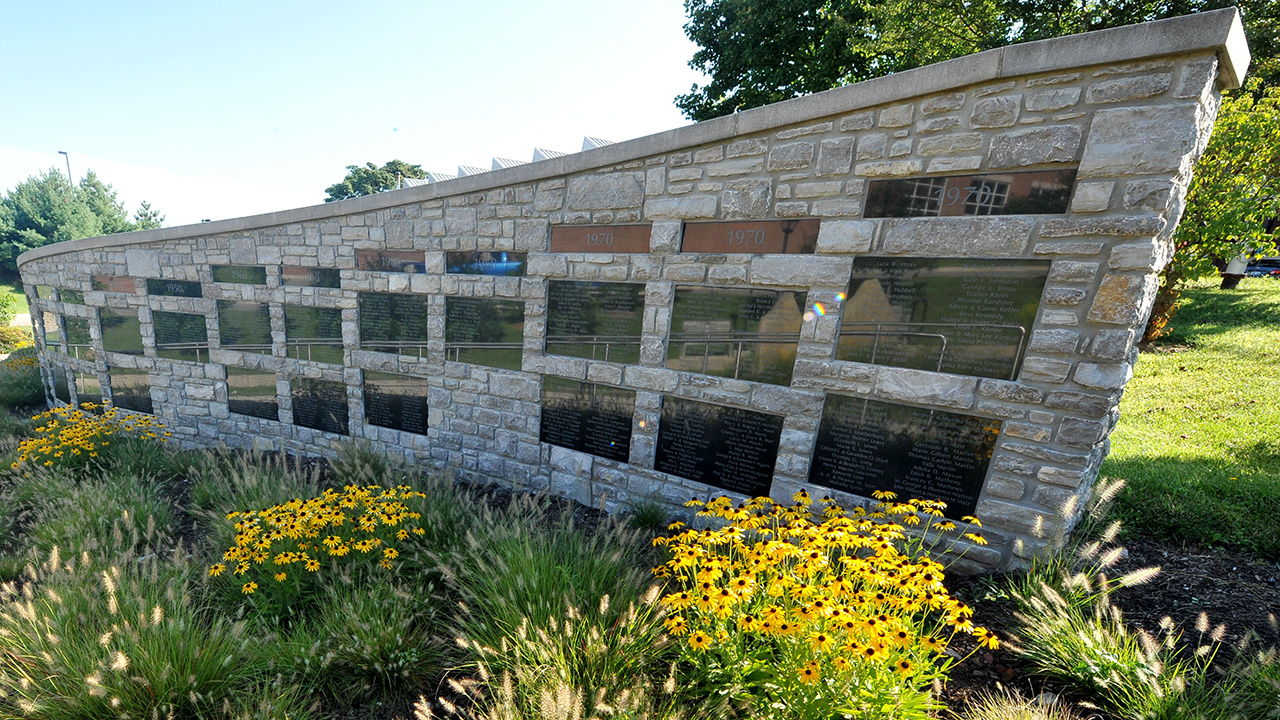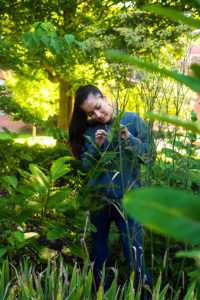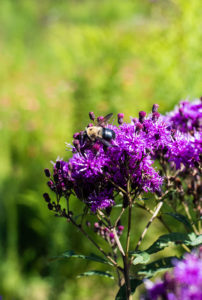
Bee Campus USA is an initiative of the Xerces Society for Invertebrate Conservation, a nonprofit organization based in Portland, Ore. Its mission is to galvanize communities and campuses to sustain pollinators by providing them with healthy habitats rich in a variety of native plants and free of pesticides. Berea College was officially certified as an affiliate of the Bee Campus USA program in 2019. For more information, visit the Bee Campus USA website.

Bee Campus USA Committee

Chair
- Teri Thompson, Vice President for Strategic Initiatives
Members
- John Abrams, Naturalist/Research Technician
- Rosemarie Adams, Landscape Specialist
- Dr. Nancy Gift, associate Professor of Environmental Studies, Chair of the Sustainability & Environmental Studies Department
- Kenny Holbrook, High Tunnel and Equipment Improvement Associate: Horticulture
- Laurie Roelofs, First Lady
- Wendy Warren, Forestry Outreach Center Coordinator
- Dewey Williams, Grounds Superintendent
- Rose Cottrill, Landscape Specialist
- Ashe Hacker, SI/LADO Program Associate
Bee Campus USA Committee meetings occur every third Monday of the month at 1 p.m.; Meetings are currently held virtually.
Child Development Lab (CDL)
- Bee Balm
- Common Milkweed
- Goldenrod
- Joe-Pye-Weed
- Lemon Balm
- Mountain Mint
- New England Aster
- Rudbeckia
- Shasta Daisy
Front of the President’s House
- Bee Balm
- Joe-Pye-Weed
- Larkspur
- Purple Cone Flower
- Rudbeckia
- Shasta Daisy
- Veronica
Back of the President’s House
- Cat Mint
- Columbine
- Common Milkweed
- Perennial Sage
- Rudbeckia
- Sedum (Autumn Joy)
- Shasta Daisy
- Swamp Milkweed
- Yellow Primrose
Butterfly Garden
- Bee Balm
- Butterfly Weed
- Cat Mint
- Columbine Larkspur
- Common Milkweed
- Joe-Pye-Weed
- Litris (Blazing Star)
- New England Aster
- Penrnsetum
- Rudbeckia
- Sedum (Autumn Joy)
- Shasta Daisy
- Swamp Milkweed
- Yellow Primrose
Alumni Fields Garden
- Bee Balm
- Calico Aster
- Common Milkweed
- Goldenrod
- Iron Weed
- New England Aster
- Rudbeckia
Highway 595 College Farm Land
- Bee Balm
- Butterfly Weed
- Calico Aster
- Common Milkweed
- Crown Vetch
- Fleabane
- Goldenrod
- Iron Weed
- Jewelweed
- Joe-Pye-Weed
- Mallow
- Mist Flower
- New England Aster
- Perennial Sunflower
- Primrose
- Purple Cone Flower
- Queens Lace
- Rudbeckia
- Swamp Milkweed
- Virgins Bower (Wild Clematis)
- Wild Columbine
- Yarrow
Marketing and Communications
- Bee Balm
- Butterfly Bush
- Coreopsis Baptesia
- Mountain Mint
- Perennial Salvia
- Purple Cone Flower
- Rose of Sharon
- Rudbeckia
- Shasta Daisy
- Yellow Primrose
bell hooks Garden
- Bee Balm
- Common Milkweed
- Rudbeckia
Boone Tavern Hotel and Restaurant
- Crabapple
- Crocus
- Japanese Lilac Bult
- Redbud
- Yellow Wood
Forestry Outreach Center
- Aromatic Aster
- Blazing Star
- Butterfly Milkweed
- Common Milkweed
- Flat-topped Aster
- Hairy Foxglove
- Mountain Mint
- Orange Coneflower
- Purple Coneflower
- Spotted Beebalm
- Swamp Milkweed
- Thin-leaved Mountain Mint
- Whorled Milkweed
Polyester Bees (Colletidae)
- Modest Masked Bee (Hylaeus modestus)
- Cellophane Bee (Anthophila sp.)
- Yellow-Masked Bee (Hylaeus sp.)
- Unequal Cellophane Bee (Colletes inaequalis)
Sweat Bees (Halictidae)
- Pure Green Sweat Bee (Augochlora pura)
- Green Sweat Bee (Augochlorini sp.)
- Agapostemon sp.
- Metallic Epauletted-sweat Bee (Augochloropsis metallica)
- Dark-winged Sweat Bee (Lasioglossum fuscipenne)
- Lasioglossum sp.
- Dialictus sp.
- Sphecodes sp.
- Ligated Furrow Bee (Halictus ligatus)
- Paraugochloropsis sp.
- Halictinae sp.
- Halictini sp.
- Bicolored Striped Sweat Bee (Agapostemon virescens)
- Orange-Legged Furrow Bee (Halictus sp.)
- Metalic Blue-Green Sweat Bee (Augochloropsis sp.)
Mining Bees (Andrenidae)
- Spring Beauty Miner Bee (Andrena erigeniae)
- Andrena sp.
- Large Miner Bee (Melandrena sp.)
- Carlinville Miner Bee (Andrena carlini)
- Neighbouring Miner Bee (Andrena vicina)
Leafcutter and Mason Bees (Megachilidae)
- Taurus Mason Bee (Osmia Taurus)
- Hostile Leaf-cutter Bee (Megachile inimical sayi)
- Leaf-cutter Bee (Megachile sp.)
- Mason Bee (Osmia sp.)
- Carpenter-Mimic Leaf-cutter (Megachile xylocopoides)
- Megachile petulans
- Paranthidium jugatorium
Bumble, Carpenter, Honey and Other Bees (Apidae)
- Common Eastern Bumble Bee (Bombus impatiens)
- Brown-belted Bumble Bee (Bombus griseocollis)
- Western Honey Bee (Apis Mellifera)
- Eastern Carpenter Bee (Xylocopa virginica)
- Two-spotted Bumble Bee (Bombus bimaculatus)
- American Bumble Bee (Bombus pensylvanicus)
- Two-spotted Long-horned Bee (Melissodes bimaculatus)
- Zadontomerus sp.
- Nomada sp.
- Melitoma taurea
- Digger Bee (Melissodes sp.)
- Fiery-Tailed Bumble Bee (Pyrobombus sp.)
- Cuckoo Bee (Nomada sp.)
- The Cosmopolitan Bee (Ceratina sp.)
- Nimble Ceratina (Ceratina strenua)
- Bumblebee (Bombus spp.)
- Confusing Bumble Bee (Bombus perplexus)
Berea College uses “No Spray” practices on our main campus, which means that our Grounds Management Team does not use pesticides or herbicides to kill insects or plants. Many of these lawn care products contain toxic chemicals that can be absorbed by the skin, ingested, or inhaled. Such exposure has been linked to allergic reactions, cancer and birth defects. Therefore, we allow all native plants to grow, while maintaining a tidy landscape.
However, the Grounds Management Team does make an effort to remove non-native plants, as they can have detrimental effects on local ecosystems beyond their potential benefits to pollinators. Bush honeysuckle is one such non-native, “invasive” plant. Even though it blooms and provides nectar to insects and birds, it also chokes out native plants by growing more quickly. Find out more about non-native and invasive plants in your area by going to the National Invasive Species Information Center.